
South Room.—West Side.
No. 114 "Portrait of Philip, the 2d Earl of Hardwick"
Mannings # 1960
Current title: "Philip Yorke, 2nd Earl of Hardwicke (1720-96)"
Location: Untraced

This picture remains untraced by Mannings and also does not appear to have been engraved. It was exhibited again in 1883 in the Grosvenor Gallery, where the catalogue describes it as "in peers robes, right hand raised in front, left hand resting on a book lying on a table" (quoted in Mannings). Surviving descriptions also mention a curtain and a background landscape.
The sitter was the eldest son of Philip Yorke, first Earl of Hardwicke, and Margaret Cocks. In 1740, he married Lady Jemima Campbell (1722-97), the eldest daughter and heir of Henry the Grey, last Duke of Kent. Although the marriage seems to have been orchestrated with an eye to reinforcing Yorke ambitions with Grey estates, it proved a steady and happy union. Their two daughters, Amabel and Mary Jemima, are portrayed in the show at No. 21. The couple also had at least two sons.
Philip began his political career in 1741 as a member of the House of Commons of Reigate, Surrey. After his father's death in 1764, Philip succeeded to the earldom and took his seat in the House of Lords. His poor health, however, prevented him from being very active in either of these roles.
Further Reading:
Entry for "Yorke, Philip, second Earl of Hardwicke (1720-1790)," in Oxford Dictionary of National Biography (Oxford UP, 2004).
Entry for his wife,"Yorke [née Campbell], Jemima, suo jure Marchioness Grey (1722-1797), letter writer," in Oxford Dictionary of National Biography (Oxford UP, 2004).
South Room.—West Side.
No. 115 "Portrait of the late Mr. Whitbread"
Mannings # 1873
Current title: "Samuel Whitbread I (1720-96)"
Location: Private Collection

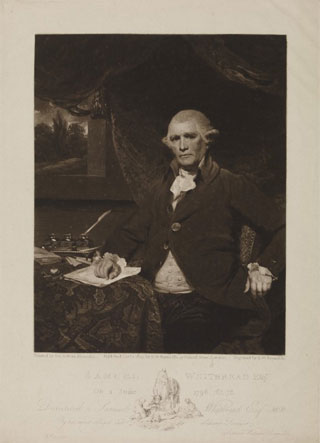
Whitbread, the seventh of eight children, grew up in a Puritan farming community at Cardington, near Bedford. In 1750, he purchased the King's Head brewery on Chiswell Street in London, renaming it the Hind's Head after the Whitbread family coat of arms. With this thriving London operation, Whitbread modernized the brewing industry. The brewery received royal attention in 1787, earning a visit from the king and queen, three princesses, and an assembly of aristocrats. When Whitbread died, brewery production was a staggering 202,000 barrels per year.
Whitbread was MP for Bedford from 1668-1790, when his son took over his seat. He spoke almost exclusively on brewing-industry topics, with the exception of his warm advocacy for the abolition of the slave trade.
Whitbread's wealth, especially in landed property, was augmented by marriage. His first marriage, in 1757, to Harriet Hayton (d. 1764), with whom he had a son, Samuel, whose portrait hangs just opposite in this room (No. 104). Harriet died only a few months after giving birth. Five years later, Whitbread married Lady Mary Cornwallis, a younger daughter of Earl Cornwallis. Sadly, she died the following year, while giving birth to their daughter, Mary Grey (1770-1858).
This portrait was painted on copper, presumably as a nod to that metal's extensive use in the brewing industry.
Further Reading:
Entry for "Whitbread, Samuel (1720-1796), brewer and landowner," in Oxford Dictionary of National Biography (Oxford UP, 2004).
South Room.—West Side.
No. 116 "St. Agnes"
Mannings # 1504
Current title: "Mrs. Quarrington"
Location: Private Collection

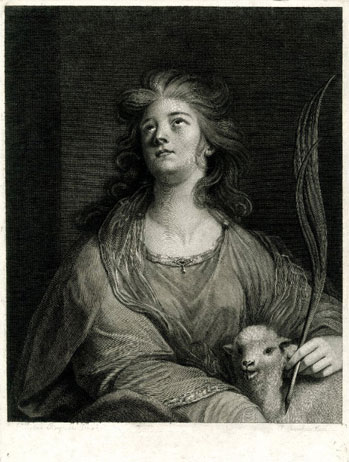
The actress Mrs. Quarrington (fl. 1771) is depicted in the role of St. Agnes, with a lamb and a palm branch. She wears what Mannings describes as a "vaguely 'historical' brown gown over a pink dress and with a blue cloak over her right shoulder."
This picture hangs beside the portrait of entertainer Elizabeth Hartley, in the role of Madonna (No. 117). The pairing of these two actresses may reinforce their shared profession, just as the pairing of Burney and Baretti below them, in turn, places a momentary emphasis on scholarship.
So little is known about the sitter, however, that some historians allege that this Mrs. Quarrington was not an actress at all but merely a well-born client. Whatever her background, she is not explicitly identified in either the show's Catalogue or the painting's popular print.
South Room.—West Side.
No. 117 "Portrait of Mrs. Hartley, as a Madonna"
Mannings # 855
Current title: "Mrs. Hartley (1751-1824)"
Location: Private Collection
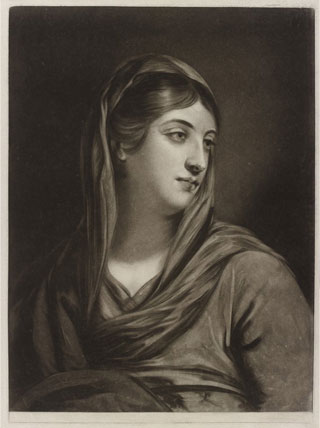
Painted around 1772-3, actress Elizabeth Hartley appears in the role of Madonna, dressed in pink with a brown veil. Although both e-gallery images show only the black and white engraving, the pink of this painting matches the hue of the nearby dress worn by Mrs. Quarrington as "St. Agnes" (No. 116).
Elizabeth Hartley also appears at No. 47 and No. 53. Please see the notes at these portraits for more information about Hartley's life and career.
Further Reading:
Entry for "Hartley [née White], Elizabeth (1750/51-1824), actress," in Oxford Dictionary of National Biography (Oxford UP, 2004).
South Room.—West Side.
No. 118 "Portrait of Dr. Charles Burney"
Mannings # 290
Current title: "Dr. Charles Burney (1726-1814)"
Location: National Portrait Gallery, London

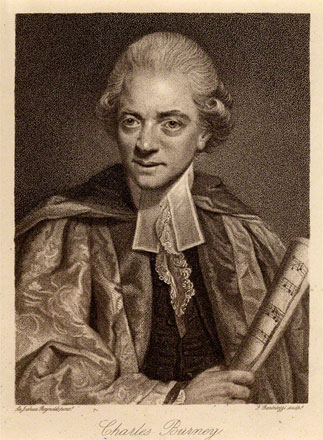
The youngest son of James MacBurney and Ann Cooper, Burney was a talented musicologist, composer, and teacher. He published the four volumes of his successful General History of Music between 1776 and 1789. Although Burney also composed music, he is remembered for his scholarship.
This portrait was prepared for the Streatham Gallery in 1781, where it hung between those of Baretti (No. 119 here) and Burke. Burney wears the formal academic gown and silk hood designating a Doctor of Music at the University of Oxford.
He was the father of novelist Frances Burney, whom Austen greatly admired. According to Frances' memoirs of her father, Reynolds' sister allegedly mistook the thick hair in this portrait for an awkward wig while it was being painted. This anecdote is perhaps more amusing in light of the great praise this picture received, during the Royal Academy exhibit in 1781, for being a particularly strong likeness.
Further Reading:
Entry for "Burney, Charles (1726-1814), musician and author," in Oxford Dictionary of National Biography (Oxford UP, 2004; online edn. 2006).
South Room.—West Side.
No. 119 "Portrait of the late Mr. Baretti"
Mannings # 107
Current title: "Giuseppe Baretti (1719-1789)"
Location: Private Collection

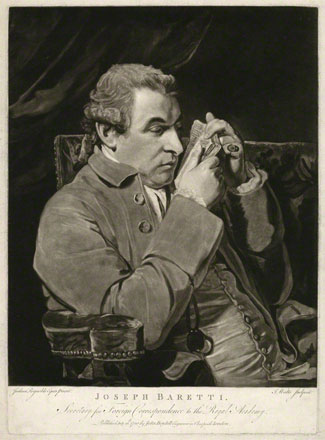
Born in Turin, Italy, Giuseppe Baretti discovered his passion for literature in Venice, where he met Gasparo Gozzi, one of the age's most influential literati. He moved to England in 1751, teaching Italian to novelist and writer Charlotte Lennox in exchange for lessons in English. Lennox introduced Baretti to prominent men such as Reynolds, Henry Fielding, David Garrick (No. 32), and Samuel Johnson (No. 130). In 1760, Baretti published A Dictionary of the English and Italian Languages and in 1778 translated Reynolds' first seven Discourses into Italian.
While Burney's nearby portrait in academic robes presents a public persona, this painting shows Baretti in a private moment. Caught in the act of nearsighted squinting while reading a book, Baretti's portrait is ever so slightly indecorous—the seemingly candid and good-humored portrait of a close friend rather than a formal client.
Baretti, who wears a flashy, red, pinky ring, was apparently a stylish dresser. Historians point out how Baretti's hairstyle marks him as, if not vain, at least fashion-conscious: "the cadogan style then favoured by the 'macaronis,' as ultra-fashionable young men were then known." (quoted in Mannings)
Further Reading:
Entry for "Baretti, Giuseppe Marc'Antonio (1719-1789), writer," in Oxford Dictionary of National Biography (Oxford UP, 2004).
Antje Blank, "Dress," in Jane Austen in Context, ed. Janet Todd (Cambridge UP, 2005), 334-251.
South Room.—West Side.
No. 120 "Portrait of Count la Lippe"
Mannings # 1132
Current title: "Frederick William Ernest Lippe, Count of Shaumburg (1724-77)"
Location: The Royal Collection

Frederick Lippe was a soldier. He was a distant royal, since his mother was the daughter of George I and the Duchess of Kendal. He commanded the British army in Portugal in 1761 and married Elizabeth von Friesenhausen (d. 1764). On his dark blue uniform, he wears the ribbon of the Black Eagle of Prussia.
According to Mannings, this large portrait, painted in the mid-1760s, was likely commissioned by Lord Townshend, along with the matching portrait of the Marquis of Granby two canvases to the right (No. 125). Townshend had served under both these generals. In 1810, Lady Townshend gifted the two portraits to the Prince Regent, who is listed as their owner in the 1813 Catalogue.
South Room.—West Side.
No. 121 Portrait of Lady Anne Fitzpatrick
Mannings # 630
Current title: "Lady Anne Fitzpatrick (born?1768)"
Location: Museum of Fine Arts, Boston

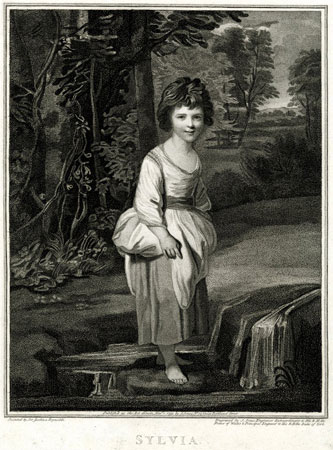
Lady Anne (1768-1841) was the daughter of John Fitzpatrick, second Earl of Upper Ossory (1745-1818), and Anne Liddell (1737/8-1804), who bore her while still officially married to the Duke of Grafton.
While little is known about Lady Anne, her mother had been the talk of all London when she was the Prime Minister's wife and Duchess of Grafton. After a series of ugly marital disputes in 1764, the Duke and Duchess of Grafton separated, with the Duchess defiantly establishing an independent household in Upper Grosvenor Street. Her friend Horace Walpole introduced her to John Fitzpatrick, second Earl of Upper Ossory. By 1767, it was public knowledge that the Duchess and Ossory were lovers. Anne's birth in August of 1768 prompted Grafton to prosecute his estranged wife for adultery. The Duchess, who had already lost custody of her three young children by her husband, accepted an allowance in lieu of a countersuit for the Duke's own well-known infidelities. Three days after the Duke and Duchess officially divorced, the former Duchess married Lord Ossory. As Lady Ossory, she retreated into rural retirement, largely avoiding public life.
The painting, probably completed in 1775, resembles in composition the nearby portrait of Anne's younger sister Gertrude (No. 127). Anne and Gertrude inherited the Fitzpatrick estates in Ireland, but neither ever married.
The popular title of this painting, "Sylvia," was taken from the 1791 print, reproduced on the left.
Further Reading:
Entry for mother, "Fitzpatrick, [née Lidell] Anne, Countess of Upper Ossory [other married name Anne FitzRoy, Duchess of Grafton] (1737/8-1804), correspondent of Horace Walpole," in Oxford Dictionary of National Biography (Oxford UP, 2008).
South Room.—West Side.
No. 122 "Portrait of Lord Boringdon and his Sister"
Mannings # 1398
Current title: "John Parker and his Sister Theresa (1772-1840)"
Location: Saltram, The National Trust

Theresa Parker sits dutifully in a creamy dress and cap trimmed with pink, her hands folded demurely in her lap. Her older brother John, dressed in a red velvet coat, embraces her protectively while looking at the viewer.
John Parker married Lady Augusta Fane in 1804, whom he divorced in 1809 for Frances Talbot. Theresa Parker married George Villiers, son of the first Earl of Clarendon, in 1798. John would be created first Earl of Morley in 1815. A portrait of their mother, a well-known art collector, hangs in the North Room (No. 18).
This has been referred to as one of Reynolds' most successful portraits of children, because neither too stiff nor gimmicky. Reynolds allegedly commented "that the Boy's Head was the finest he had ever done" (quoted in Mannings).
Further Reading:
Entry for mother, "Arianne Burnette, 'Parker , Theresa (1745-1775)," in Oxford Dictionary of National Biography (Oxford UP, 2004).
South Room.—West Side.
No. 123 "Portrait of His R. H. the Duke of York"
Mannings # 690
Current title: "Frederick Augustus, Duke of York and Albany (1763-1827)"
Location: The Royal Collection

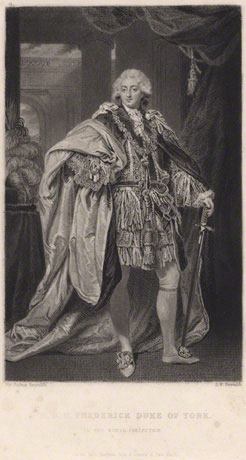
Prince Frederick was the second son of George III and Queen Charlotte. His portrait faces that of his older brother, the Prince Regent (No. 95). In 1791 he married Frederica Charlotte, Princess Royal of Prussia, with whom he had no children. He was promoted to Field Marshall in 1795 and Commander-in-Chief of His Majesty's Forces in 1798.
York's reputation as an army officer and a military reformer was undermined by scandal in 1809. Already known for his rakish extravagance, York took adventuress Mary Ann Clarke (1776?-1852) as his royal mistress. While their affair ended in 1806, it later proved that Clarke had made money from her association with the Duke "by promising promotion to officers, in return for payment" (ODNB). In 1809, when this came to light, the House of Commons held hearings to determine whether York had knowingly been involved in the trafficking of offices. Although York was censured for his carelessness, he was not convicted of wrongdoing. York nonetheless resigned as Commander-in-Chief in order to end the embarrassing inquiry, which had already resulted in a flurry of pamphlets and caricatures. In May 1811, the Prince Regent reinstated his brother at the head of the army, a move that was, by then, generally approved.
Dramatically, York wears his Order of the Garter robes. Critics at the Royal Academy exhibit complained that the Duke's legs were poorly painted.
Further Reading:
Entry for "Frederick, Prince, Duke of York and Albany (1763-1827), army officer and bishop of Osnabrück," in Oxford Dictionary of National Biography (Oxford UP, 2004; online edn. 2007).
Entry for "Clarke, Mary Anne (1776?-1852), royal mistress," in Oxford Dictionary of National Biography (Oxford UP, 2004; online edn. 2007).
South Room.—West Side.
No. 124 "The Fortune-teller"
Mannings # 2070
Current title: "A Fortune-Teller"
Location: Iveagh Bequest, Kenwood

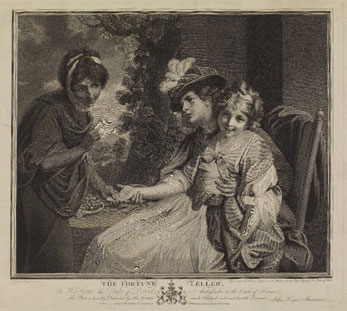
This is a studio copy of the painting in the North Room owned by the Duke of Dorset (No. 12) and most likely completed in 1781. For more information about this composition and the tradition of fortune-telling, see the notes at No. 12.
Further Reading:
Penny Gay, "Pastimes" in Jane Austen in Context, ed. Janet Todd (Cambridge UP, 2005), 337-345.
South Room.—West Side.
No. 125 "Portrait of the Marquis of Granby"
Mannings # 1199
Current title: "John Manners, Marquess of Granby (1721-70)"
Location: The Royal Collection

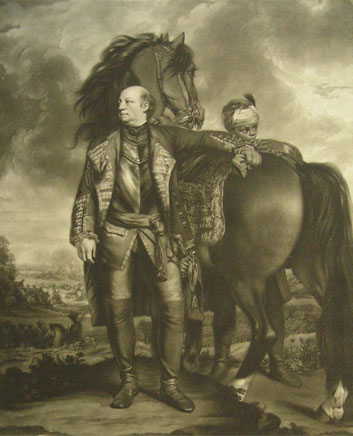
The Marquis was the eldest son of John Manners, third Duke of Rutland, and Bridget Sutton. In 1759, he was promoted to Lieutenant-General and served in the Seven Years' War, proving a particularly effective leader of the cavalry. "His tactical judgment was unerring" on the battlefield, but he struggled constantly with his mounting debt, around £60,000 upon his death (ODNB).
This was painted in the mid-1760s, together with the "Portrait of Count la Lippe" (No. 120). These two army generals stand, as it were, on either side of the Duke of York, as if supportive of the recently reinstated Commander-in-Chief.
Granby is depicted at the 1761 Battle of Vellingshausen, wearing the dark blue uniform of a general but no hat or wig. The loss of his hat during one charge apparently gave rise to the expression "To go at it bald-headed" (having lost most of his hair by his late twenties, Granby disdained wigs). Reynolds dramatically contrasts the pale form of Granby's bald head with the "glowing dark face of his black page" and the color of his gleaming horse (Mannings).
Further Reading:
Entry for "Manners, John, Marquess of Granby (1721-1770), army officer and politician," in Oxford Dictionary of National Biography (Oxford UP, 2004).
South Room.—West Side.
No. 126 "Portraits of a lady and child"
Mannings # 911
Current title: "Mrs. Richard Hoare (1743-95) and Child"
Location: Wallace Collection, London

Although the 1813 Catalogue does not identify the sitters, this is a portrait of Susanna Cecilia Dingley, the daughter of Robert Dingley of Lamb Abbey, cradling her infant. Susanna had married Richard Hoare of Boreham House, Essex, in 1762. Richard Hoare was a partner in Hoare's Bank.
Susanna's cream-colored dress is decorated with small sprigs of golden flowers that are neatly echoed by Reynolds in the flora of the painting's outdoor setting.
South Room.—West Side.
No. 127 "Portrait of Lady Gertrude Fitzpatrick"
Mannings # 632
Current title: "Lady Gertrude Fitzpatrick (1774-1841)"
Location: Columbus, Ohio, Museum of Art

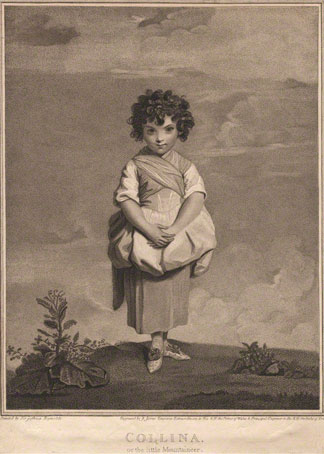
Lady Gertrude was the model for "Girl with Grapes" (No. 19) and the sister of Lady Anne Fitzpatrick (No. 121).
Gertrude is the younger daughter of John Fitzpatrick, second Earl of Upper Ossory and Anne Liddel, formerly Duchess of Grafton. For notes on the scandal surrounding their love affair and marriage, see No. 121. According to Henry Bone, Gertrude's curly hair distinguished her from her darker sister Anne.
The painting was engraved in 1782 as "Collina, or the little Mountaineer." The title of the print may explain why the overskirt of the girl's dress has been tucked under—to allow for better climbing and playing. Both Anne and Gertrude's portraits show the Fitzpatrick girls dressed in this rustic and tomboyish manner, perhaps to indicate their rural innocence after the family's deliberate remove from town life.
South Room.—West Side.
No. 128 "Portrait of Francis, Marquis of Tavistock"
Mannings # 1555
Current title: "Francis Russell, Marquess of Tavistock (1739-67)"
Location: Duke of Marlborough, Blenheim Palace

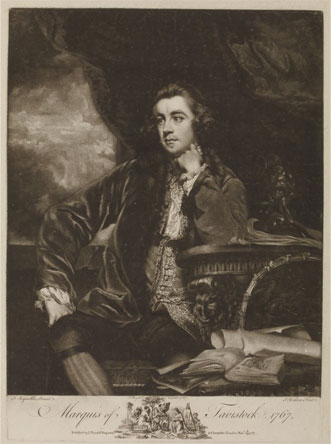
Russell was the only surviving son of John, fourth Duke of Bedford, and his second wife Gertrude. At 25, he married Lady Elizabeth Keppel (No. 22), with whom he had a son, Francis. Tragically, Russell was killed falling from a horse during a hunt only a few years later. This portrait was painted the year he died. Elizabeth died of consumption (some said a broken heart) the next year, aged 28. Elizabeth was the sister of Admiral Augustus Keppel (No. 111).
Russell wears a fur-trimmed, red, velvet coat over a richly decorated waistcoat. The pensive pose and "carefully chosen accessories" in this portrait are meant to commemorate Russell's travels in Italy (Mannings). He made his Grand Tour from 1761 to 1762, collecting paintings, books, and sculptures. The bronze statuette at his left elbow is, Mannings explains, of Samson and the Philistine, an item brought back from his Grand Tour and still displayed at Woburn Abbey, the ancestral home of the Duke of Bedford.
The "Duke of Marlborough" is listed as the owner in the 1813 Catalogue. Russell's sister, Caroline, had married the fourth Duke of Marlborough.
Further Reading:
Entry for son, "Russell, Francis, fifth Duke of Bedford (1765-1802), agriculturist and politician," in Oxford Dictionary of National Biography (Oxford UP, 2004).
South Room.—West Side.
No. 129 "Portrait of Lord Amherst"
Mannings # 54
Current title: "Sir Jeffrey Amherst (1717-97)"
Location: Mead Art Museum, Amherst College

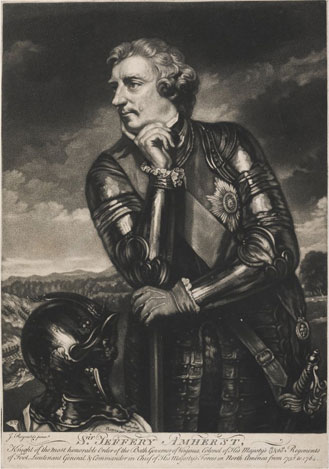
Jeffrey Amherst was the son of Jeffrey Amherst and Elizabeth Kerrill and served as a soldier in Ireland, Germany, and North America. He married his cousin Jane Dalison (d. 1765) in 1753 and Elizabeth Cary in 1767. Neither marriage produced children.
Lord Amherst is depicted out of doors and preparing for battle. He wears a gleaming suit of medieval-like armor, adorned with the ribbon and star of the Order of the Bath. In the background, troops in canoes are on their way to the siege of Montreal that took place in 1760.
Amherst, like Francis Russell beside him (No. 128), pensively gazes off to the side while resting on an elbow. Displayed side-by-side, the similarity of their poses highlights, perhaps, their different fates and situations.
Further Reading:
Entry for "Amherst, Jeffrey, first Baron Amherst (1717-1797), army officer," in Oxford Dictionary of National Biography (Oxford UP, 2004).
South Room.—West Side.
No. 130 "Portrait of Samuel Johnson"
Mannings # 1014
Current title: "Samuel Johnson (1709-84)"
Location: Tate Gallery, London

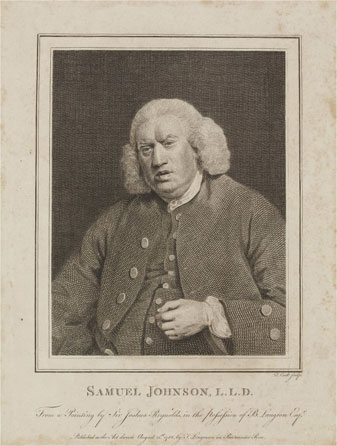
Samuel Johnson is arguably the most distinguished man of letters in English history. His astonishing range as a writer includes criticism, satire, biography, the moral essay, fiction, scholarly editing, travel writing, journalism, and lexicography. He launched his career in the 1730s with a poetic satire entitled London: a Poem in Imitation of the Third Satire of Juvenal. In 1755, he published his long-awaited Dictionary, an extraordinary record of the English language and, through judicious quotation, its literary canon. Another standout work was Johnson's 1779 series of prefaces for a multi-volume collection of English poets entitled The Lives of Poets.
Johnson and Reynolds became close friends. Like the nearby painting of Baretti (No. 119), this portrait projects informality, as if Reynolds catches the great writer mid-sentence. Johnson allegedly disliked it, referring to this painting as "blinking Sam."
Critics assume that Jane Austen was, at the very least, familiar with James Boswell's biography of the great writer, The Life of Samuel Johnson (1791), which is listed among the books owned by her brother in the Godmersham Park Library Catalogue. The Godmersham library also held "Anecdotes of Johnson London 1786" by Hesther Lynch Piozzi—the owner of this painting in 1813.
Further Reading:
Entry for "Johnson, Samuel (1709-1784), author and lexicographer," in Oxford Dictionary of National Biography (Oxford UP, 2004; online edn. 2009).
Peter L. De Rose, Jane Austen and Samuel Johnson (UP of America, 1980).
South Room.—West Side.
No. 131 "Portrait of Oliver Goldsmith"
Mannings # 737
Current title: "Oliver Goldsmith (?1730-74)"
Location: National Gallery of Ireland, Dublin

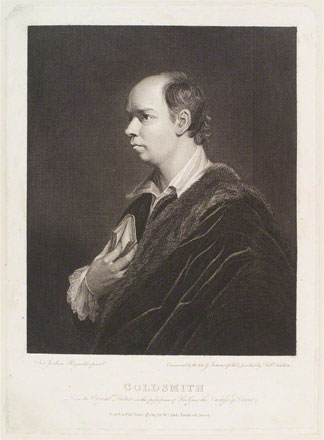
Anglo-Irish author Oliver Goldsmith is best remembered for the novel The Vicar of Wakefield (1766), the poem The Deserted Village (1770), and the play She Stoops to Conquer (1773). He never married. A founding member of the Literary Club, he was a close friend of Reynolds, to whom he dedicated The Deserted Village, and also of Samuel Johnson, whose portrait fittingly hangs beside him (No. 130). Profligate habits and recurring money troubles led Goldsmith to call upon Johnson for assistance on more than one occasion.
As a child, Goldsmith was severely disfigured by smallpox. With a receding chin and protruding brow, Goldsmith's looks made him a subject of ridicule (one newspaper referred to his "monkey face" and "grotesque oran-outang figure"). In this portrait, Reynolds softens the poet's features, painting him in profile holding a book close to his heart.
Jane Austen made hundreds of annotation in the margins of her brother James' four-volume copy of Oliver Goldsmith's The History of England (1771) before writing her very own "History of England" in 1791. Austen's short history, written at age 15 and illustrated by her sister Cassandra, is part of Austen's surviving juvenilia.
Further Reading:
Entry for "Goldsmith, Oliver (1728?-1774), author," in Oxford Dictionary of National Biography (Oxford UP, 2004; online edn. 2009).
Jane Austen, "History of England," in the Juvenilia volume of The Cambridge Edition of the Works of Jane Austen, ed. Peter Sabor (Cambridge UP, 2006). Sabor includes Austen's marginal comments to Goldsmith's History of England as Appendix B.
South Room.—West Side.
No. 132 "Portrait of Kitty Fisher as Cleopatra"
Mannings # 612
Current title: "Catherine Fisher (Kitty) (d. 1767)" or "Cleopatra Dissolving the Pearl"
Location: The Iveagh Bequest, Kenwood

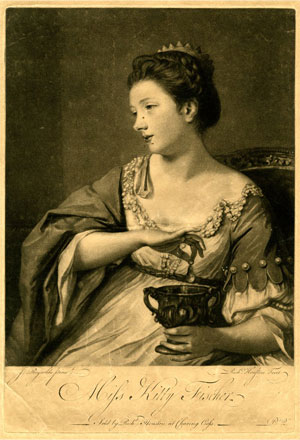
"Kitty" Fischer was the most prominent London courtesan in Reynolds' time. The multiple portraits of her by Reynolds increased her fame. This pose is taken from a portrait of Cleopatra by Francesco Trevisani (Mannings).
A famous legend has it that Cleopatra made a bet with her lover Marc Antony to see who could spend the greater fortune on a meal. She won by dissolving a large and valuable pearl in vinegar (some say wine), defiantly drinking down the concoction to show her disdain for wealth. Kitty Fisher's extravagance was similarly legendary. One well-known, if probably apocryphal, story records that she ate a £100 bank note on buttered bread, relishing the shock value this produced in her companions. By likening Fischer to Cleopatra in this portrait, Reynolds counterbalances the courtesan's legendary recklessness with the gravity of history.
Although Fischer had many patrons and admirers, she married John Norris (1740-1811) in 1766. She died of consumption the following year.
Due to Fischer's dubious celebrity, the diminutive "Kitty" for Catherine came to be temporarily associated in popular culture with loose morals. Used in Pride and Prejudice for one of the most flirtatious of the Bennet sisters, the nickname never attaches itself to the innocent heroine of Northanger Abbey, Catherine Morland.
Further Reading:
Entry for "Fischer [married name Norris], Catherine Maria [known as Kitty Fisher] (1741?-1767), courtesan," in Oxford Dictionary of National Biography (Oxford UP, 2004; online edn. 2008).
Maggie Lane, Jane Austen and Names (Blaise Books, 2002).
South Room.—West Side.
No. 133 "Portrait of Sir Charles Davers"
Mannings # 482a
Current title: "Sir Charles Davers, 6th Bt (1737-1806)"
Location: Saltram, The National Trust

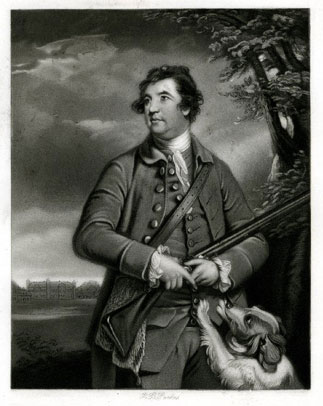
Davers was the third son of Sir Jermyn Davers, fourth Baronet of Rushbrooke, and Margaretta Green. Upon the death of his elder brothers, Davers succeeded to the baronetcy in 1763. He served as a soldier in the army, with a stretch of service in North America. Although he never married, he had eight natural children by Frances Treice.
Mannings describes Davers as wearing "a red coat with gold buttons" and identifies the building in the background as a "view of Rushbrooke," the family home in Suffolk. Upon Davers' death in 1806, this estate became the property of a nephew (as Davers' many children were not legitimate).
In the painting, Davers caries a rifle and is accompanied by an excited pointer, as if captured in the midst of a casual hunt on his estate. In Sense and Sensibility, Austen likewise introduces her story's rake, John Willoughby, in this same guise: "A gentleman carrying a gun, with two pointers playing round him."
Further Reading:
Thomas Keymer, "Rank," in Jane Austen in Context, ed. Janet Todd (Cambridge UP, 2005), 387-396.
